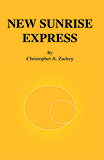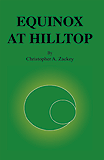
| New Sunrise Express | Equinox at Hilltop | An Introduction to the Mythology | ||
| Christopher A. Zackey | Christopher A. Zackey | Christopher A. Zackey | ||
| Xlibris, 132 pages | Xlibris, 128 pages | The Rose and Lily Press, 186 pages, spiral bound |
|
A review by Georges T. Dodds
Equinox at Hilltop tells of Isoceles and four other 'wizards' hired by Mayor Angstrom of the hilltop village of Hilltop, plagued with yearly worsening attacks of flying bicycles from the moon, not to mention the at times belligerent telephone-bearing trees of the surrounding forest. The wizards include Isoceles, a shy slide-rule wielding mathematician, Andante, a female musician and vision of beauty, Worderhorn Jones a brash boisterous John Waynish man with a car to match ("With me and my car to honk the way, we can have a wham good time here, and mix business with pleasure."), Chrysyphus, the owner of a hot-air balloon whose cabin expands into a multi-dimensional home, and Vindrosen, a haughty rake who vies with Isoceles for Andante's affections. Behind all the humour and oddball people lurks an ancient tragedy, which events bring to the fore. Besides the story, there is the language itself, less overtly referential to Zackey's Mythology, but lovely at times nonetheless: The moon swam into focus like a dish offering a festival of feasts. The mathematician gasped breath; all around the moon's cratered contours buzzed dark, savage bicycles, like primeval wasps from a giant hive. In and out of craters they flew, as if winged, their agile frames suggesting implicit stingers. Many times the spoked wheels left the surface of the moon in hungry leaps, perhaps anticipatory to later flights they might make to Hilltop New Sunrise Express is more explicitly linked to Zackey's Mythology than Equinox at Hilltop. Here, in a story which mixes The Polar Express with the Christian myth of the ill-fated 1212 "Children's Crusade" (vs. current historians' views—see links at left) a group of young children board a train which will take them across an alternate United States, and eventually over the Wivern Mountains to the Holy Land. Again there are a number of odd, quirky characters, from Orn Huffer, the big burly but good-hearted engineer, to Mr. Beanbag, the evil conductor and his friend Rast Strichter, the motorcycle-gang leader-cum-train robber. The child characters/passengers are paired off into male-female couples early on, and between episodes of abuse from various nefarious villains, attempt to imparting seress on one another. There are moments when the children's cutesy-cutesy cuddly-wuddly interactions might get a bit too Care-bearish for some: Trembling, her eyes full of glisten, she encircled him [Jan] with her long arms, and clasped the long-fingered hands so he was locked within her circle.but there's enough humour, whimsy and crackpot, off-the-wall situations arising that this can be easily ignored. An Introduction to the Mythology, available through the author's website, is neither a work of fiction nor the outline of a fantasy world like Middle Earth, Hyperborea or Narnia. Rather it is a series of philosophical essays outlining the author's Mythology, a unified theory of seen and unseen, spiritual and material. While it appears to originate in Roman Catholicism, it encompasses and expands upon the latter and other belief structures. While one might disagree with religiously conservative statements like "girl-boy romance is the root sacredness behind all things..." there is plenty here that a recent prefect of the Congregation for the Doctrine of the Faith might not agree with. While, as a materialist, I don't agree with many of Zackey's premises—or by extension, his conclusions—they are lucidly presented and discussed, if at times in stream of conscious manner. Reading An Introduction to the Mythology certainly cleared up a lot of what New Sunrise Express was about Is Zackey's fiction 'commercial?' or ever likely to outsell the Robert Jordans of the world? Not in the least—it doesn't slavishly follow Tolkienian tropes (though it clearly draws something from L. Frank Baum), it is entertaining, whimsical—something almost entirely absent in today's fantasy—quirky-funny, yet bearing a serious underlying message, and the prose is a quasi-poetry of portmanteau words and quirky images, ably mixing modern American culture with pure fantasy. I highly recommend Equinox at Hilltop and to a slightly lesser extent New Sunrise Express to readers looking for something fresh and original.
Georges Dodds is a research scientist in vegetable crop physiology, who for close to 25 years has read and collected close to 2000 titles of predominantly pre-1950 science-fiction and fantasy, both in English and French. He writes columns on early imaginative literature for WARP, the newsletter/fanzine of the Montreal Science Fiction and Fantasy Association and maintains a site reflecting his tastes in imaginative literature. |
|
|
If you find any errors, typos or anything else worth mentioning,
please send it to editor@sfsite.com.
Copyright © 1996-2014 SF Site All Rights Reserved Worldwide

